HISTORY IN THE DEVELOPING WORLD (THIRD WORLD)
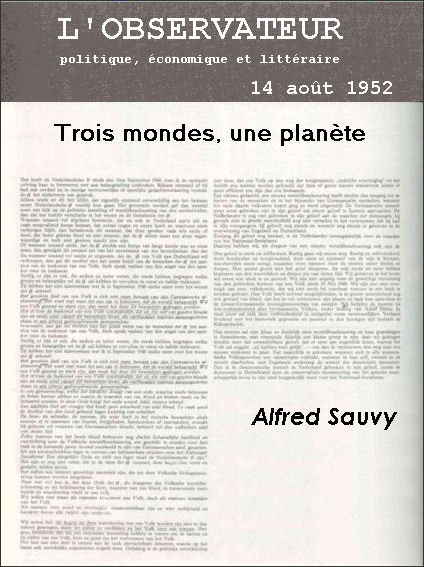
Appearance of the term "Third World" The term "Third World" was first used by a French journalist in the 1950s to describe countries which were not part of the industrial world (the First World) or the Communist bloc (the Second World). These days it is more politically correct to use the term “developing world” — with the richer, industrialized nation being the “developed world” — and describe Third World nations as “developing countries.”
By one count there are 139 developing countries. By the late 2000s, according to another reckoning, the Third World consisted of about 50 countries — many of them in Sub-Sahara Africa as well as countries like Laos, East Timor, Yemen, Kyrgyzstan, Haiti and Bolivia — and it embraced about 1 billion people and no longer included China and India.
Colonization and Imperialism
Colonialism is defined as the policy of one nation seeking to extend its powers over other territories. In the 18th and 19th centuries, European nations became stronger and richer through industrialization as nations and empires outside of Europe became weaker because they failed to industrialize. Increasingly, the European nations began eyeing counties outside Europe as sources of raw materials and markets for their goods and as outright colonies.
Imperialism is defined as the policy of one nation or empire extending the rule of authority over foreign states. It often involves the acquisition of territory of one state by another to exploit its resources. The Palestinian scholar Edward Said once referred to imperialism as “geographical violence.” In the 18th and 19th centuries, imperialism became a major focus of foreign policy. India provides a classic example of how it worked: cotton grown in India for Britain was shipped to Manchester, England where it was made into finished goods which were sold back to India for a tidy profit.
The colonized countries found their local economies destroyed — or at least dramatically transformed — as their populations were mobilized to produce and consume goods for the mother country rather for themselves. The population of the colonized country became second class citizens as the people in the mother country began to think of themselves as superior and feel it was their duty to civilize the people in the colony.
The process was not entirely negative. The Europeans brought their laws, education systems and views about civilization. But they also exerted pressure by controlling trade, defining the terms of the trade and forcing the colonies to become indebted to them so they could demand concessions. The local elite in the colonized countries often became fascinated by the West. They began using European languages instead of their native ones and attended European universities.
European Occupation
In the 16th and 17th centuries Portugal and Spain were the main global powers. In the 18th century Britain emerged as the dominant world power followed in France and the Netherlands. By the 19th century the world was divided up by the European powers. Britain and France and to a lesser extent Germany, Italy, and the Netherlands (and Japan too in some places) ruled their separate “spheres influence” so they wouldn’t have to challenge one another.
For the most part, the Europeans were able to suppress opposition within the countries they ruled. They increased trade, used raw material to feed industries back home, and improved infrastructure by building roads, railways and electricity plants and improving irrigation projects. Distances that once took weeks to cover were covered in days. Schools were built that offered a European-style education. Some were built by the colonizers, other by Christian missionaries. These improvements were spotty and generally didn’t have much affect on the majority of the population.
Dividing Up Africa at the Berlin Conference in 1885
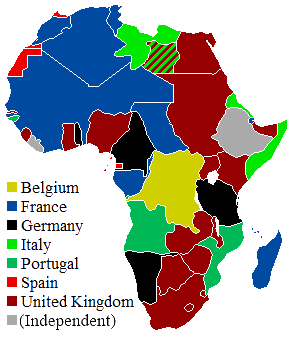
Colonial Africa 1914Many of Africa's problems can be traced back to Berlin Conference when the major powers of Europe sat around a conference table and divided up Africa according to "spheres of influence." The three-month conference was hosted by the order-minded German Chancellor Otto von Bismark who wanted to establish some rules for the conquest of Africa and divided it up in such as way that Europe's major powers wouldn't get into costly battles over territory when there was plenty to go around. [Source: Glen Frankel, Washington Post, January 9, 1985]
The Berlin Conference began on November 15, 1884. All the nations of Europe, save Switzerland, were invited to the conference, but the biggest players were France, Germany and Britain. The Germans got present-day Tanzania, Cameroon and Namibia. The French took most of West Africa, including the Sahara. The British made out like bandits with Egypt, the Sudan, most of southern Africa, Kenya, Nigeria and Ghana. The Portuguese were granted Angola, Mozambique, the Italians got Libya, Eritrea and part of Somalia, and Spanish received a few small pieces of land on the Atlantic coast. King Leopold II of Belgian got present-day Democratic Republic of the Congo (Zaire), with all of its mineral riches. The only African state that remained independent was Ethiopia. [Ibid]
Leopold II was one of the more bizarre and notorious figures in the scramble for African territory. The constitutional Belgian monarch, he claimed what is now the Congo, not for Belgium but for himself as a private profit-generating state without any support of the Belgian government. Leopold ended up getting what he wanted — an area of Africa the size of the United States east of the Mississippi. The conference gave into his demands because of a chain of events that began with a dispute between Leopold and a French rival over a treaty secured from a chief in the Congo.
At the Berlin Conference, Portugal was given title to territory 22 times larger than itself. The British used the Portuguese as a tool to keep land away from the French. The Germans given title to Tanzania not because they claimed it but because the British thought giving it them was an effective way to placate German Chancellor Otto von Bismark. Also at the conference slavery, ritual murder and ordeal by poison were declared illegal.
"The Europeans came and assumed command of African history," wrote British historian Basil Davidson, "and the solutions they found were solutions for themselves, not for Africans." At that time Africa consisted of several hundred independent states that varied greatly in size, power and advancement. After the conference large tribes found themselves divided up in two or more states and traditional enemies found themselves bound together.
By 1886 the European powers had staked out their claims on the coast. By 1890 Britain, France and Germany had concluded a set of treaties that divided up the interior in terms of "spheres of influence" that radiated out for their coastal possessions. The last round of partition treaties that defined Nigeria, the Gold Coast, central Africa, and the eastern Sudan were concluded in 1899. Refinements were made between 1900 and 1905. After World War I the German possessions of Togo and the Cameroons were partitioned between France and Britain and Rwanda and Burundi were taken from Tanganyika and given to the Belgian Congo. Also the British got Tanzania and South-West Africa was transferred to South Africa. [Source: "The Imperial Experience in Sub-Sahara Africa Since 1870" by Henry S. Wilson, University of Minnesota Press]
African Borders

Belgian Lado Coat of arms
After the Berlin Conference and the terms of the various treaties were worked out the borders were drawn. Some of the borders were drawn straight along lines of longitude or latitude, which divided, for example, the Ewe between Ghana, Togo and Benin. A straight line boundary divided the Masai between the Germans and British in present-day Kenya and Tanzania. In most cases natural boundaries were used, which was destructive to local cultures because tribes often identified themselves with or located themselves around a river or mountain. Tribes that lived along rivers were split into one country on one shore and another on the shore. Mountain dwelling tribes were split in a similar fashion. Frontiers between the Nile, Congo and Zambezi basins, for example, divided the Azande and the Lunda peoples not the rivers themselves.
The British prime minister, Lord Salisbury, commented at an Anglo-French convention in 1890: "we have been engaged in drawing lines upon maps where no white man's foot has ever trod; we have been giving away mountains and rivers and lakes to each other, only hindered by the small impediment that we never knew exactly where the mountains and rivers and lakes were."
At first there were so few Europeans in Africa that the boundaries meant little to the people in Africa. Nomads migrated with their flocks where the seasonal rains took them, tribes honored the same territories they always had, and caravans continued to follow their traditional routes. But as time went on the lines laid down arbitrarily on the map of country that had hardly been surveyed, let alone studied anthropologically, became real borders. [Source: Glen Frankel, Washington Post, January 9, 1985]
Africa traditionally had wide buffer zones — "where there was considerable cultural and ethnic overlap" — instead of sharply delineated European-style borders. Sparsely populated Africa generally did the have the same kind of disputes over land that heavily populated Europe had.
After World War II there was talk of eliminating the Berlin Conference borders and drawing up new more thoughtful boundaries. There was also a movement to create a United States of Africa. "In the end," Glen Frankel wrote in the Washington Post , "the Organization of African Unity, designed to bring Africans together, became a tragicomic monument to their enduring separation...Africa has become atomized into smaller, conflicting groups. People identify themselves by tribe, ideology, profession, religion or economic class, seldom by nation." [Source: Glen Frankel, Washington Post, January 9, 1985]
Britain and France Divide Up the Middle East After World War I
The defeat of Germany and the Ottomans in World War I resulted in Ottoman Turkey losing much of its territory, the fall of the sultanate, the liberation of the Arabs and a mad scramble in the Middle East for control of the remnants of the Ottoman Empire.
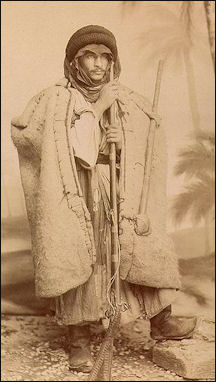
Bedouin chiefThe Treaty of Versailles, which formally ended World War I, provided for the Arab countries, formally under Ottoman rule, to be provisionally recognized as independent in accordance with terms set up by the states given “mandates” over them.
The 1920 Treaty of Sevres, written by the victorious Allies, broke up the Ottoman Empire. In January 1921, despite his failure at Gallipoli, Winston Churchill was appointed colonial secretary and put in charge of reorganizing the Middle East. Then a cabinet member who served as both the Air Minister and War Minister, he proposed reforming the Ottoman Empire because he saw nothing but trouble ahead in a region. No one took him seriously.
In March 1921, a ten-day conference was held at the Semramis Hotel in Cairo. Almost everybody who was anybody in the Middle East was there. On the agenda was what to do with the entire Middle East with the exception of Egypt, whose was fate was worked out separately by Britain and Egypt. [Source: David Fromkin, Smithsonian magazine]
The biggest point of contention was Syria. The British had placed it under the control of Prince Faisal, son of Hussein. After Syria declared independence, the French answered back by occupying all of Syria-Lebanon. Faisal was sent into exile and later became the ruler of Iraq.
Under the terms of mandates granted by the League of Nations, the Middle East was effectively divided up between France and Britain under "spheres of influence," with France setting up protectorates in Syria and Lebanon, and Britain setting up protectorates in Palestine, Iraq and Transjordan. The Arabs were outragesd because they had been promised independence.
Drawing Up the Borders of the Middle East Nations
The current borders of the Middle Eastern nations were established by Britain and to a lesser France. Most of the borders were drawn up in 1922 by a British civil servant whose primary goal was to map out the Middle East to accommodate British military and administrative institutions. T.E. Lawrence later boasted that he, Churchill and handful of others mapped out the modern nations of the Middle East over dinner.
To protect Iraq from attacks by Ibn Saud, the leader of Saudi Arabia, Iraq was granted land claimed by Ibn Saud?all the land west of the Euphrates River to the Syrian frontier. To appease Ibn Saud, the British transferred the rights to two thirds of the territory of Kuwait, which had been virtually independent for two centuries. This land contained valuable grazing lands and oil. These were the borders that Saddam Hussein claimed were invalid when he invaded Kuwait in 1990.
The borders of the Middle East were drawn up based on British and French interests and ignored local history and traditions. Many of the problems that have subsequently arisen in Iraq, Kuwait, Israel and Palestine can be traced back to how the borders were drawn and the land was partitioned. The French drew a new border for Lebanon and Syria that paved the way for problems and civil war in the 1970s and 80s.
Plantation Agriculture
Although most of the money from African exports during the colonial period came from mining, agricultural exports also increased. The land was cultivated one of three ways: 1) by peasant farmers on small plots of land; 2) black laborers on farms owned by white settlers; or 3) on large plantations run by big companies. Peanuts, cocoa and palm oil were the major export products.
White plantations often failed because the farmers were ignorant of tropical agriculture and their specialized farms were vulnerable to pests and disease. There was a shortage of labor so new plantations had a hard time attracting labor cheap enough to make their enterprises profitable.

Porters in the Belgian Congo
"The development of the [cocoa] industry," wrote Nigerian governor Hugh Clifford, "has been practically spontaneous on the part of the inhabitants. The inevitable result of the rapid increase of the people's wealth has been to bring about what almost amounts to a revolution. The commensal ownership of the land is being largely repudiated for individual ownership.; the sale of the land , and almost unheard of practice has became a matter of everyday life; a tendency for the maker of a cocoa plantation to leave his property to his son rather than his sister's son has brought about a change from matrilineal to patrilineal descent.”
In Africa: White Man's Burden, Missionaries and Alcohol
Africans at the end of the 19th century were generally know to Europeans as "natives," "wogs," "fuzzy-wuzzies," "savages," "kaffirs," and "niggers." Politicians tried cast themselves as humanitarians without being branded as a"nigger lovers."
"White Man's burden" is the notion that it was the duty of the white to impose its superior culture, morality and religion on the dark people of the earth. The British justified their incursions into Africa with the understanding that it was the "white man's burden" to help Africans advance. The French said they were on a" civilizing mission” there. During this period when the philosophy of Social Darwinism and "scientific" racism were in vogue it was an accepted fact in Europe that Europeans were superior to Africans.
Most Europeans believed that Africans wanted to be dominated and even liberals and humanitarians felt it was the duty of the Western powers to civilize Africans through education and religious training. This paternalistic policy was led by the missionaries who were often subsidized by per capita grants from the colonial governments to educate black Africa.
European Christians believed it was their moral duty to convert barbaric African heathens to civilized Christianity. The relationship between Europeans and non-Europeans was often cast in metaphorical terms. The Europeans were often called the "more developed brother" and the Africans were "less developed children." Blacks were also characterized "as the lady of the races." [Source: "The Imperial Experience in Sub-Sahara Africa Since 1870" by Henry S. Wilson, University of Minnesota Press].
The missions played a much larger role educating black Africans than the colonial governments did. They also believed it was their moral duty to stamp out traditional African religions and customs such as circumcision, polygamy and dancing.
Europeans believed they were a disciplined race able to drink sensibly, whereas other races were not. But despite this it was common practice for plantation owner to pay their workers with palm wine from West Africa, "Cape smoke" brandy" from South Africa or "Trade rum" imported from the Caribbean.
An antonymous African in 1872 wrote a missionary newspaper called the “Kaffir Express": "Oh ye Britons, be true Britons still, “and kill us not any more with brandy". You know the kaffir mind, merely childlike; “we cannot help ourselves", put brandy a little further off, as you would anything that you considered not fit food for your child, and which the child was making efforts to grab...Ye are killing us with brandy."
British Rule
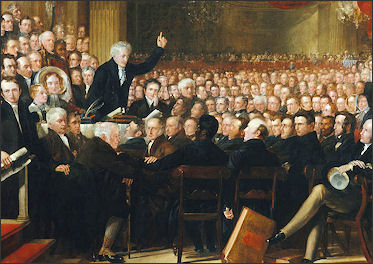
Anti-Slavery Society Convention 1840 Many new states were labeled as protectorates, a vaguely defined state that could be almost anything its rulers wanted it to be. "With reference to the word 'protection' as used in the proposed treaty,” a 19th century British Consul in Africa wrote, “the Queen does not want to take your country or your markets, but at the same time is anxious no other natives should take them. She undertakes to extend her gracious favor and protection, which will leave your country still under your government. She has no wish to curb your rule, although she is anxious to see your country get up."
To gain control of large group of people with a small colonial force, the British used the divide-and-rule strategy which they developed in India. Under this strategy, the British fanned religious rivalry and conflicts between local rulers to keep the local population from unifying against them. They took control of large chunks of territory by granting sovereignty of a portion of it to local leaders who were given power in exchange for protection. The remaining territory they seized for themselves.
To maintain order, the British employed both direct and indirect control methods. Under direct control, the British allied themselves with important chiefs and leaders. After World War I, the British adopted an indirect style of rule in which British recognized existing societies and assisted them in adapting themselves to meet the needs of the colonial government."
Back home in Britain, for the most part it seemed ordinary people didn’t care much about what was going on in the colonies. One historian wrote, “The House of Commons was notoriously thinly attended when colonial issues were brought before it.”
French Rule
French colonial rulers developed a style of indirect rule during their occupation of Africa in which: 1) annexations were registered by treaties in which France "recognized X as king of Y"; 2) France promised to respect and enforce the local laws and customs as long as they were not contrary to humanitarian principals; and 3) France vowed to interfere as little as possible with the designated rulers. In practice the person designated "king" was often an usurper, rebel or stooge for the Europeans and local laws and customs were often ignored.
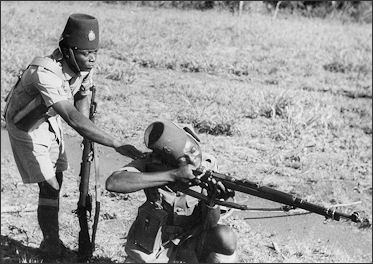
Soldiers in the Belgium Congo France gave its colonies French-style government institutions and often seemed as interested in transforming the local population into Frenchmen and women as in making money. The people in French colonies — the local elite anyway — were generally much better educated than their British counterparts. To participate in the government local people had to read and write French which was viewed as a way to assimilate them. The French had enough confidence in the local elite to leave them in control when they retreated back to France when the weather became oppressively hot.
In the 1890s the French changed the focus of their colonial policy from "assimilation" to "association," partly motivated by the fashionable theory that culture was hereditary, and it was therefore more productive for “the native" to develop in his own way.
Lacking the manpower to govern such a large territory France turned over huge tracts of land to chartered companies who often ruled quite ruthlessly. A New York Times reporter wrote in 1952: "French penetration was accompanied by highly uneconomic methods of colonization...France simply assumed the title to all the land and then proceeded to portion vast tracts of it out on a concession basis to large monopolistic companies...These companies developed all the human and natural resources that they could easily get their hands on and returned virtually nothing for the economy of the country."
Life Under the European Occupation After World War I
The populations of colonized countries grew dramatically under European rule, primarily due to improvements in health and agriculture. There was also waves of immigrations of Europeans and too a lesser extent people from other countries.
The local elite consisted primarily of landowners who supplied raw materials to the Europeans and people who received a European-style education. Few Europeans knew the local languages and there was relatively little social mixing and intermarriage.
Cinemas, nightclubs, radio stations and newspapers opened up. Foreign tourists arrived in increasing numbers. Local artists became influenced by European styles. Local artistic styles began spreading around the globe. A popular music scene developed. The rigors of local religions were relaxed. Women gained more freedoms.
Young men were sent to European universities to study. They brought back ideas of democracy and civil liberties along with technical and scientific knowledge.
After World II, the Europeans were able to regain control of their territories, but devastated by the war they lacked the means to control them, especially as calls for independence and democracy grew, and they steadily lost their grip on power.
The British policy was to support independence and try to help the countries advance economically and technologically while keeping its interests and military bases intact through friendly agreements.
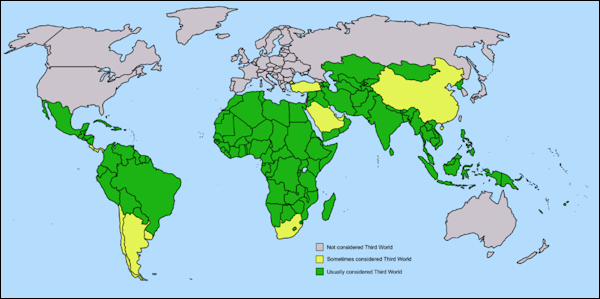
dark green considered Third World, light green sometimes considered Third World
Independence After World War II
Most former European colonies achieved independence in the late 1940s, 1950s, and early 1960s, as one one historian wrote, “by manipulation of political forces, both internal and external, and by negotiations which were relatively peaceful, in spite of moments of popular disturbance.”
The early leaders were mostly royals or educated elites that were able to win independence but were unable to appeal to ordinary people and rule with popular support.
The newly independent nations inherited the means of controlling the government: the police, military and bureaucracy. Many foreigners left. Many of their professional and administrative positions were taken over the local educated members of the middle class.
The historian Bernard Lewis wrote: “Western-style parties and parliament almost inevitably ended in corrupt tyrannies, maintained by repression and indoctrination. The only European model that worked, in the sense of accomplishing its purposes, was the one-party dictatorship.”
Maintaining the dictatorships was expensive. Money was spent on the army, police, intelligence services, planning organizations, bureaucracies that ran the government, bureaucracies that ran public sector enterprises, and on pay offs to the ruling classes, tribal leaders and key supporters. Relatively little money was left over to help ordinary people and the poor.
Life After World War II
In the 1940s and 50s, populations continued to rise. The overall population became younger. People began migrating to the cities in large numbers. While life the villages remained largely unchanged, things were changing dramatically in the cities.
In urban areas, illiteracy decreased. The use of contraceptives and opportunities for women increased. Schools were built. Homes received electricity. Even though rates of infant mortality and of infectious disease remained high, health care was improving and people were getting more to eat.
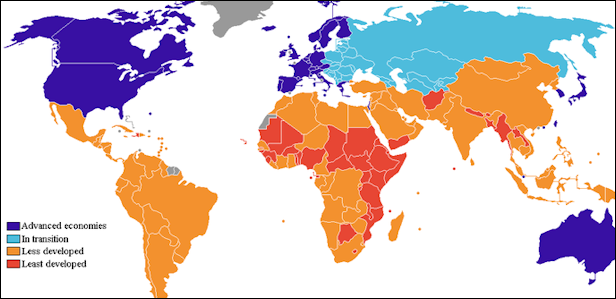
Economy After World War II
Jeffrey Sachs of Columbia University wrote: “The failure of the Third World to grow as rapidly as the First World is the result of a complex mix of factors, some geographical, some historical and some political. Imperial rule...left the conquered regions bereft of education, health care indigenous political leadership and adequate physical infrastructure.”
“Often, newly independent countries in the post-World War II period made disastrous political choices such as socialist economic models or a drive for self-sufficiency behind inefficient trade barriers. But perhaps most pertinent today, many regions that have been left further behind have faced special obstacles and hardships: diseases such as malaria, drought-prone climates in locations not suitable for irrigation, extreme isolation in mountains and landlocked regions, an absence of energy resources such as coal, gas and oil and other liabilities that have kept these areas outside the mainstream of global economic growth.”
The economies grew slowly after World War II.. There was little foreign investment. The gap between the rich and poor grew. There were large numbers of unemployed and under employed. In the countryside, peasants remained under the control of landowners.
With independence, governments controlled much of the revenues sources such as oil and local merchants obtained a lager percentage of the import-export trade. Large land owners were able to continue controlling much of the land. and were able to make handsome profits selling raw materials to Western countries.
In the 1960s and 70s, developing countries promoted self-reliance and regarded foreign investment as a form of imperialism and multinational corporations and as agents of evil.
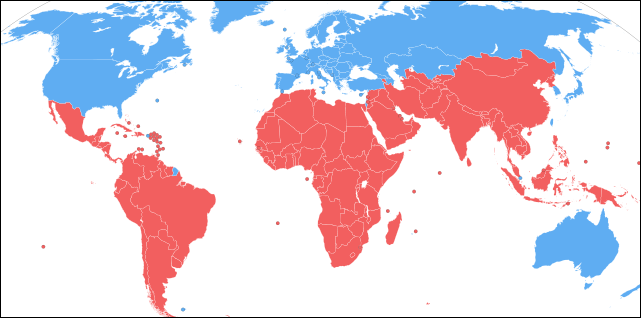
North-South divide
The boom in the 1990s left many developing nations, about 25 of them in Africa, worse off. Foreign aid declined, debts increased, AIDS-HIV rates soared and the prices of important commodities dropped.
Developing countries suffered greatly as a result of economic crisis in 2008 and 2009 even though they had nothing to do with starting it. They suffered as demand for their exports dried up, investors didn’t want to invest, loan money dried up, and developing countries were more reluctant to provide aid.
Antole Kaletsky wrote in the Times of London, “Consumers in countries such as China, India, Brazil and Indonesia have been far less affected by the financial crisis. In fact consumer credit and mortgage markets in these countries are just beginning to develop, creating the conditions for powerful growth in consumer demand.”
Cold War
In his book “Global Cold War: Third World Interventions", the Norwegian historian Odd Arne Westad argued that rather than being on the periphery of the Cold War the developing world was at the center it. Interventions by Washington and Moscow in countries such as Chile, Iran, Guatemala , Cuba, Angola, Ethiopia and the Congo, he said, had a great impact on the countries involved and the world and the affects still linger today.
Director of the Cold War Studies Centre at the London School of Economics, Westad concludes that Western involvement in the developing world in the Cold War period “was a continuation of colonization through slightly different means. And while Washington’s intervention caused its problems in countries involved the involvement ultimately did more damage to the Soviet Union, with Afghanistan, for example, playing a major role in the down fall of communism and the break up of the Soviet Union and the Eastern bloc.
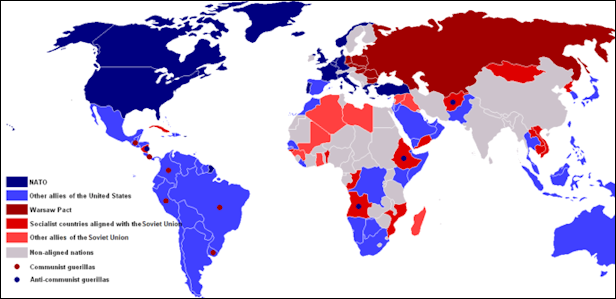
Cold War Map 1980
Image Sources: Wikimedia Commons
Text Sources: New York Times, Washington Post, Los Angeles Times, Times of London, Yomiuri Shimbun, The Guardian, National Geographic, The New Yorker, Time, Newsweek, Reuters, AP, Lonely Planet Guides, Compton’s Encyclopedia and various books and other publications.
Last updated January 2012
